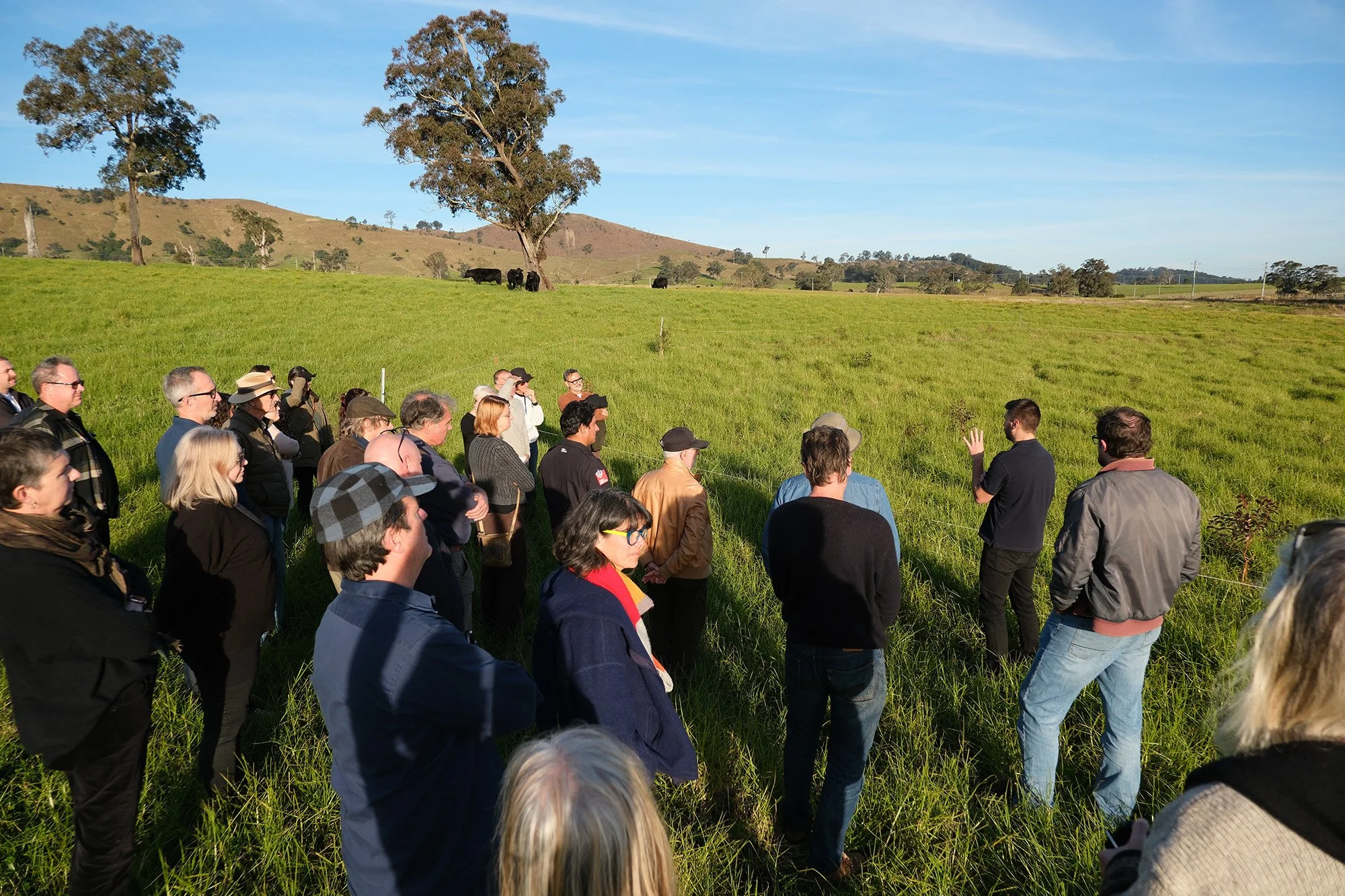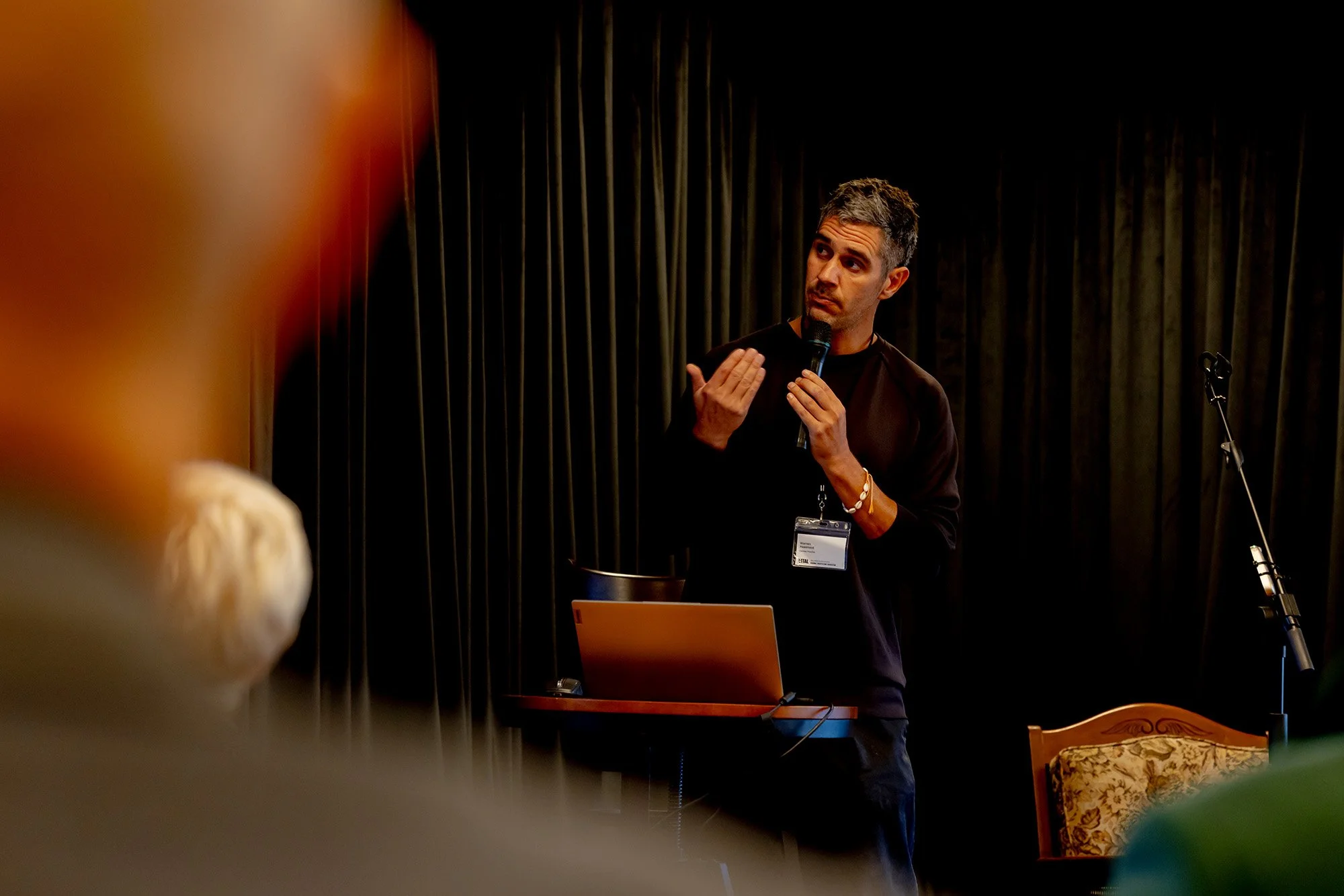VITAL: Questions of Resilience - event wrap by Natalie van der Merwe
Dungog, 19th-21st June 2025.
PHOTOGRAPHY BY MARCUS PIPER & Edwina Richards
VITAL Reflections – A Regional Perspective
Having lived and worked in regional Australia all my life, I’ve often found professional development opportunities don’t quite fit my context. So when the RAA announced an event in my hometown, I was excited. I never imagined that architecture would find its way to our small town on Gringai land, nestled by the Williams River.
Lachlan Pierce presenting to delegates, Photo by Marcus Piper
We kicked off Thursday afternoon at the Ryan family farm, just outside town. I lived a few kilometres up the road 25 years ago and was eager to see how the old dairy had been transformed. A young micro-forest greeted us on arrival, already standing 3-4m tall. Custodian Janne Ryan shared her family’s story and their regenerative journey—reviving the old bottling room as an event space overlooking the former milking shed. Her words, “you can be sentimental about a farm, but not about farming,” echoed the theme of resilience.
Lachlan Pierce presenting to delegates, Photo by Marcus Piper
Lachlan Pierce from Carbonfix broke down carbon sequestration, making it accessible and relevant. We explored planting and soil carbon projects, learning how long-term commitments like these (25-100 years!) contrast starkly with traditional farming returns. It reminded me that while our role as designer is often brief, we must still create with longevity in mind. Visiting the farm’s planting project felt like standing on the edge of a very slow construction site—one worth watching!
Committee member Emily Knight (left) with Caroline Pidcock (right) at her home, photo by Marcus Piper
Delegates gathered outside Caroline Pidcock’s home, photo by Marcus Piper
Next, we visited Caroline Pidcock’s adaptive reuse project in town—once a GP clinic, now a residence and studio in the making. Caroline’s approach prioritises livability and sustainability, dissolving the line between work and life. The courtyard garden already shows how small-scale design can make a big impact, and with 30+ attendees, the space proved its worth.
We wrapped up day one with cider and reflection among new colleagues—a great way to finish.
Day Two – A Broader Lens
Friday began with coffee at The Royal Hotel and a deep dive into the decade-long process to develop the Murrook Cultural Centre. Jason Elsley of Derive Architecture and Worimi Elder Andrew Smith spoke of their collaboration, emphasising trust, listening, and cultural integration. What unfolded wasn’t just a project walkthrough but a powerful example of architecture as cultural embodiment. Andrew spoke passionately about how Murrook is intended to reflect and carry the identity of the Worimi people—not just through built form, but through deep consultation, respect, and co-creation. Jason described how Derive’s approach focused on listening first and designing second, laying the foundation for a relationship that continues today. Their collaboration stood as a reminder that meaningful design isn’t just responsive—it’s relational.
Co creative directors Janne Ryan and Peter Salhani, photo by Edwina Richards
Jason Elsley of Derive Architecture (left) and Worimi Elder Andrew Smith (right), photo by Edwina Richards
Next, Caroline Pidcock returned to present her philosophy of regenerative architecture. What struck me most was Caroline’s commitment to aligning her career with her personal values—continuously seeking opportunities to create systemic change, not just deliver projects. Her willingness to share the influences, mentors, and resources that shaped her thinking was generous and it reminded me how valuable it is when we share our learning process, not just the outcomes.
Caroline Pidcock, photo by Edwina Richards
Warren Haasnoot from Curious Practice followed with four adaptive reuse projects, including the transformation of a shopfront in Dungog. Curious Practice’s focus on subtlety and observation—what he referred to as “micro-architectures”—showed how small interventions can have significant impact. Warren spoke about spending time with clients in their spaces, using this insight to create spaces that respect the past while revealing new potential. His work reframed my own thinking around thresholds, edges, and the in-between spaces we often overlook.
Warren Haasnoot from Curious Practice, photo by Edwina Richards
Warren Haasnoot from Curious Practice speaking about his adaptive reuse of a shopfront in Dungog, photo by Edwina Richards
After lunch, Dr. Sarah Breen Lovett offered another powerful perspective. She shared her journey navigating both academic and creative worlds, refusing to follow the path of traditional architectural practice. Her commitment to exploring natural materials, intuitive processes, and experimental forms—especially in her current FAST/SLOW project—felt necessary in today's climate. Sarah’s emphasis on expanding architectural awareness through cross-disciplinary knowledge made a strong case for curiosity as a design tool. She highlighted that the future of sustainable design depends not just on new technologies, but on new ways of thinking.
Dr. Sarah Breen Lovett, photo by Edwina Richards
We wrapped the formal sessions with a Q&A panel featuring Janne Ryan, Peter Salhani, Caroline, Jason, and Sarah. Questions sparked discussion on how to challenge established systems without the need to create entirely new ones. Themes of adaptive reuse, interdisciplinary understanding, and critical questioning—like “What is only necessary?”—were revisited. The panel explored how architecture is well-placed to reduce embodied carbon and contribute to cultural and environmental resilience.
Panel discussion with (left to right) co-creative director Peter Salhani, Caroline Pidcock, Jason Elsley and Dr Sarah Breen Lovett
Our final session for the day was a sunset walk with former ABC weatherman Graham Creed, who guided us through cloud formations, weather systems, and the emerging role of AI in forecasting. As we moved through town to the sportsfield, Graham explained how weather prediction has evolved—from human intuition to data-driven modelling—and how AI is already outperforming older systems in many areas. Discussing recent weather events and how climate will continue to become more extreme drove home the importance of designing responsive architecture.
Former ABC weatherman Graham Creed, photo by Edwina Richards
Saturday – Building Change from the Ground Up
Saturday began with a visit to the hempcrete home of Shane Hannan and Clare Tilyard, currently under construction. This was a personal highlight, as I’ve worked closely with Shane and Clare on the design. Shane, one of Australia’s earliest adopters of hemp building, brings years of experience and passion for sustainable construction. The home is a result of genuine collaboration—an alignment of values, materials, and method. To be able to share the home with colleagues was really special. Brad from Arcpanel also joined, sharing his excitement at seeing a residential project post-installation.
Hempcrete home of Shane Hannan and Clare Tilyard, photo by Marcus Piper
From there, we headed into the bush to explore a regrowth forest managed by Australian Sustainable Timbers. Anabel and James, founders of the business, guided us through the dry sclerophyll regrowth forest, explaining their approach to forest stewardship. Their work challenges the idea that leaving a forest untouched is enough—highlighting that regeneration is an active, ongoing process. They focus on whole life-cycle management: assessing private land, managing growth, harvesting selectively, and processing timber.
Anabel and James (far right) of Australian Sustainable Timbers, photo by Marcus Piper
The final stop was their nearby timber mill, where we saw the transformation of log to finished product. It was fascinating to see how they process each part of the tree, with 60% of the log traditionally deemed waste being repurposed into landscaping, mulch, and agricultural products. We also got a peek at an innovative insulation experiment in their custom-built kiln—developed by the next generation of their team. This visit brought home the idea that closed-loop systems aren’t a theory—they’re happening now, and they’re scalable.
Australian Sustainable Timbers’ mill, photo by Marcus Piper
Final Thoughts
VITAL left me with a renewed sense of belonging—to a network of like-minded professionals scattered across regional Australia, and to a profession that is accepting its broader responsibilities. The event challenged, inspired, and grounded me. Most importantly, it reminded me that resilience isn’t a static trait—it’s a commitment. A practice. Something we cultivate not just in buildings, but in relationships, ecosystems, and ideas. I'm grateful to the RAA and the event organisers for curating a program that embraced depth, diversity, and dialogue. It won’t be my last.
A special RAA thanks to the Technical Experts on hand during the event: Brad Collyer from Arcpanel, Carmen Manney and Ian Harkin from Polyflor, Andrew Savage from Weathertex, Nigel Puckeridge from Paperock and Lachlan Stanton from Viridian. RAA would like to thank them for their commitment to design in the regions.
Brad Collyer from Arcpanel, photo by Edwina Richards
Carmen Manney and Ian Harkin from Polyflor, photo by Edwina Richards
Andrew Savage from Weathertex, photo by Edwina Richards
Nigel Puckeridge from Paperock, photo by Edwina Richards
Lachlan Stanton from Viridian, photo by Edwina Richards
We look forward to seeing you all in September 2025 for RAA’s first foray into Central Australia.
Want to join the RAA for our next event? Want to become a member of the RAA or know someone who would? Spread the word and reach out via this website.




















